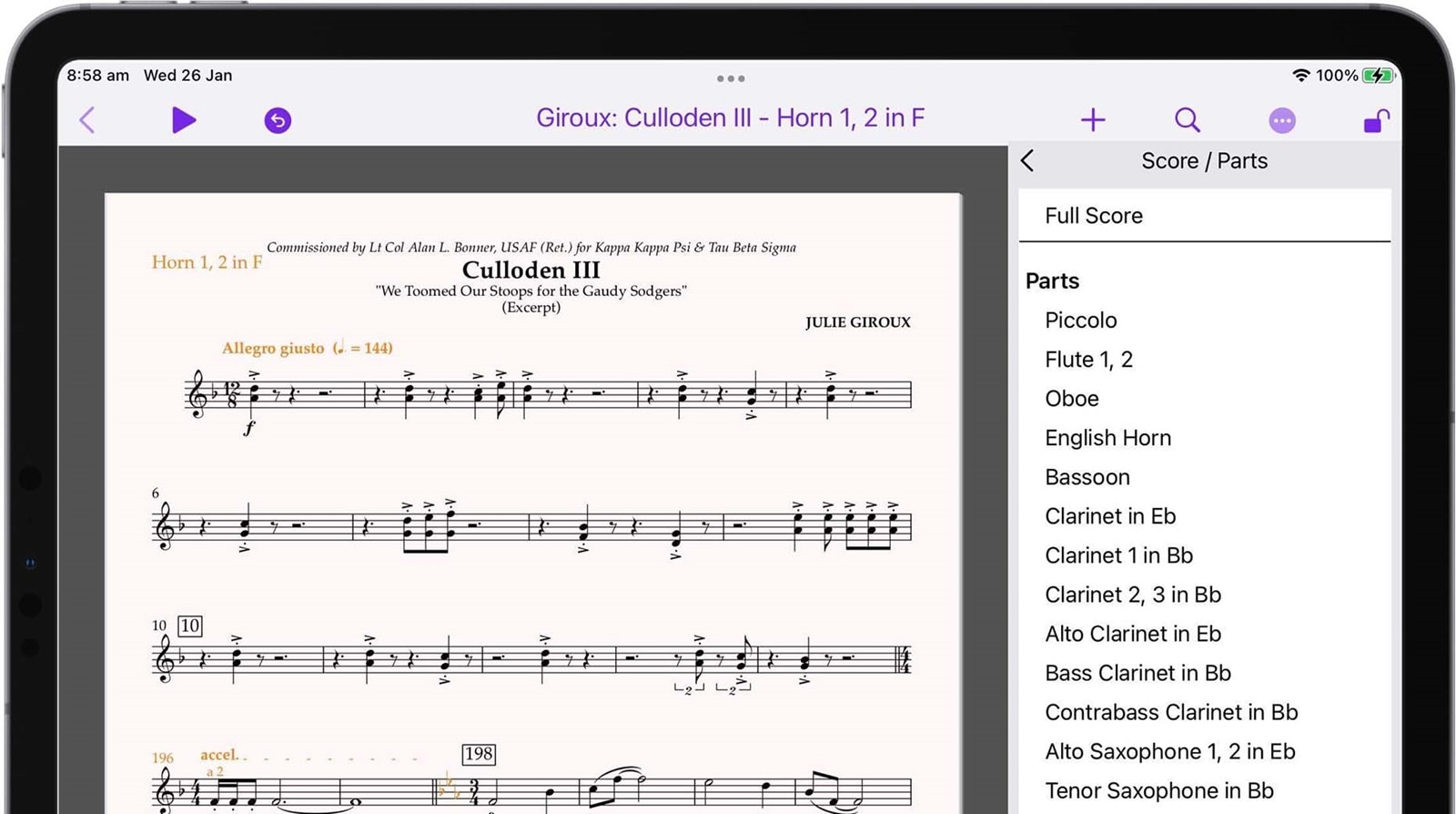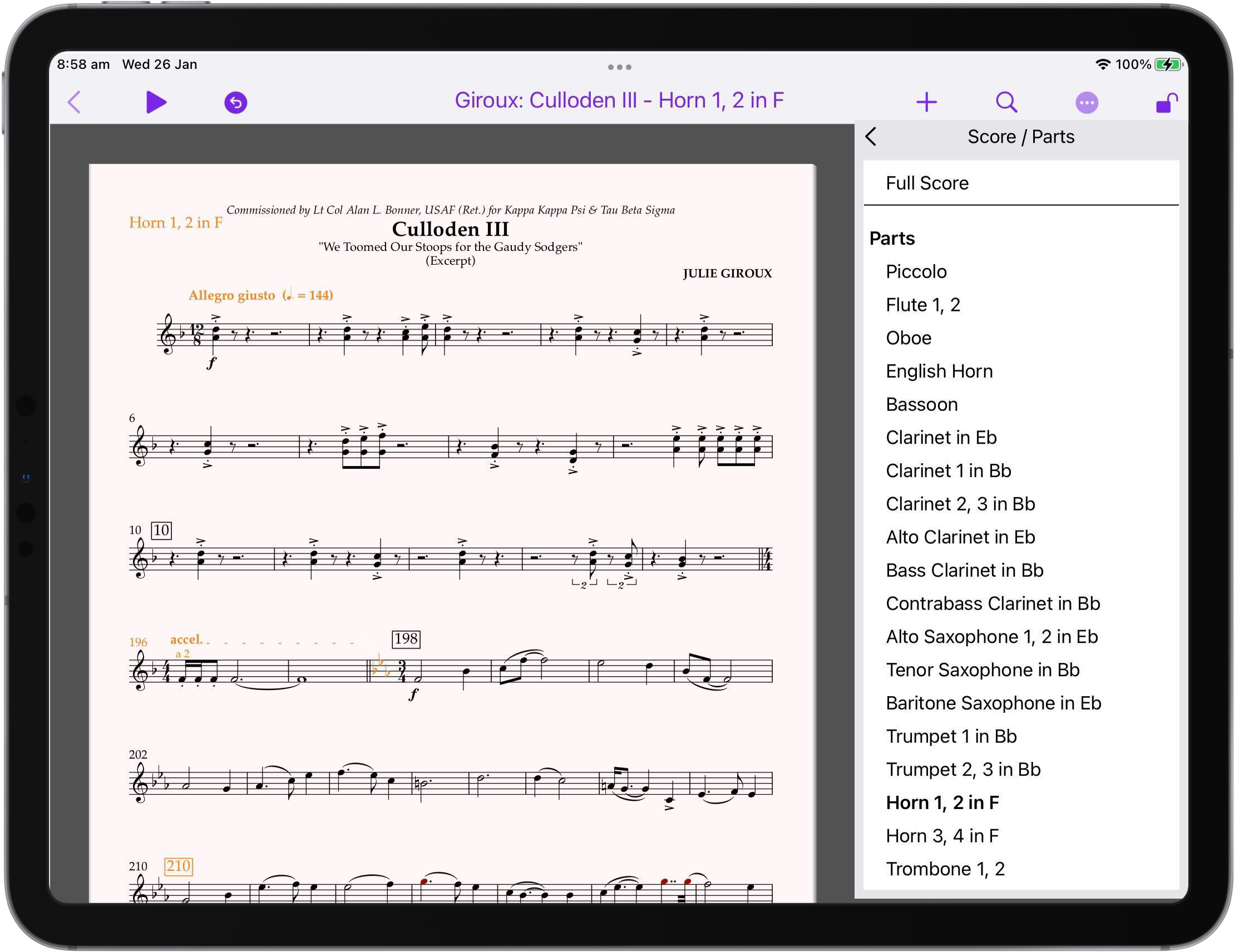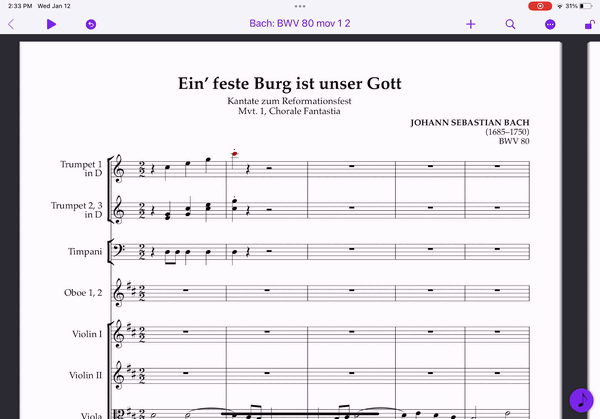

Welcome to the January release of the Sibelius for mobile. It’s been six months since we first released Sibelius for mobile, and in that time, we’ve allowed the app to evolve organically based on your feedback. And today, we’re excited to share that Sibelius for mobile now contains the most popular user request: Dynamic Parts. The 2022.1 update is now available on the App Store, and all the details are right here. Read on!
If you’re new to Sibelius for mobile, it’s our free companion app to Sibelius on desktop, and can be downloaded from the Apple App Store for both iPhone and iPad. This will run with the Sibelius | First features, and you can unlock more features within the app by either starting a new 1-month trial, or if you have Sibelius on desktop already, by signing in with your account. If you have a current subscription or support plan for Sibelius on desktop, you can unlock the features within the mobile app at no extra cost. For a full list of features, see the comparison here.
On to what’s new in this release:
Dynamic Parts Come to Mobile
The long awaited feature for Sibelius on iPad and iPhone has arrived: Dynamic Parts. We’ve packed the full power of Dynamic Parts into Sibelius for mobile, so you can expect the same high level of customization and capability that you’re used to on desktop, along with a completely reimagined user experience.
Viewing Parts
Everyone can view Dynamic Parts in any tier of Sibelius, including our free version: Sibelius | First. The application lets you open any Sibelius file and see not only the score, but also all of the parts contained within the file. If you’re working with an ensemble, you can send everyone the same Sibelius file, and everyone will be able to freely open that file and view their specific part. They don’t need to be subscribers or even sign-up for a free account, just download the free Sibelius app on an iPad or an iPhone and start opening Sibelius files—that’s it!
Parts can be accessed in the mobile app in the same way that they are accessed within desktop Sibelius: via a drop-down list (see the “Score / Parts” tab contained within the More menu), via part navigation commands (available via the Command Search) or via keypad shortcuts.

For those familiar with navigating parts on Sibelius on desktop, we’ve brought several useful commands into the mobile version, including:
- Next Part (CMD + OPT + `)
- Previous Part (CMD + SHIFT + OPT + `)
- Switch Between Full Score and Part (W)
You can find these part-related commands within a new subgroup of commands in the Command Search window, or, if you’re working in review mode (i.e. a locked score), simply call the commands directly with the shortcuts above. Remember: just like in Sibelius on desktop, the ‘W’ shortcut will switch between the full score and the last opened part, so you don’t need to always have something selected before switching back and forth between the score and part.
Part Navigation Gestures
Going further, we didn’t just port the same user experience (UX) for navigating parts into our mobile app, we implemented something entirely new! We’re pleased to introduce part navigation gestures specifically designed for touchscreen interfaces. These gestures allow users to access any part within their Sibelius files using a single touch gesture. Here’s how it works:
- Touch and hold the name of the score in the top toolbar
- Drag left or right to navigate amongst the full score and any of the parts
- Let go when you’ve found the desired part
That’s it! The new part navigation gestures unlock the ability to quickly scroll through and view all available parts, with the full score always being on the far left (allowing you to quickly return to the full score). You can perform our new part navigations gestures with the Apple Pencil, an external mouse, or via touch.
Once you’ve navigated to any particular part, you can listen to it by tapping the playback button (only the current part will sound). You can also print any part via the “Print” option in the More menu. All of these features are free to all; no login or in-app purchase required!
Editing Parts
As with Sibelius on desktop, parts are automatically laid out for you, and are dynamically linked to the full score so changes made in any part are reflected in the score, and vice versa. Notes, text, lines, and other objects are reflected in both score and part, however there are some exceptions to this:
- Staff objects (e.g. Expression text, hairpins, accidentals, etc.) appear orange if they have been moved in parts.
- Notes that have been flipped or made cue-sized in parts appear orange.
- Objects that are shown in the part but hidden (or absent) in the score, or vice versa, appear orange.
- Notes that have been enharmonically respelled in parts appear orange in the part (Sibelius | Ultimate only).
This allows you to lay out the part just the way you need without affecting the full score. For resetting items with custom-part overrides (i.e. to once again match the score), we’ve also brought over the following commands from Sibelius on desktop, which can be accessed via the Command Search or via shortcuts:
- Reset to Score Design (CMD + OPT + SHIFT + D)
- Reset to Score Position (CMD + OPT + SHIFT + P)
Note that page size and page orientation changes are specific to each part. These can be customized via the Document Setup feature within the More menu. Parts for transposing instruments (Horn in F, Clarinet in Bb, etc.) are automatically transposed for you too, so you don’t need to worry about setting this up either.
Move the Keypad
Up until now, the keypad has had just two preset positions. Now, you can move it anywhere on your screen. Simply long-press on the floating keypad button and drag to the most optimal location.

You can set different keypad positions for portrait and landscape orientations. Simply rotate your device and move the keypad wherever you need it. Sibelius for mobile will remember your preferred locations between sessions.
Improved Search Algorithm
Rounding out the changes in this release, we’ve improved the search algorithm used across the entire app. Sibelius for mobile now tokenizes your queries to provide you with better search results in both the Create menu and within Command Search. You no longer need to know the exact name for finding commands or adding score items. This change makes the app far more accessible to our new users, and it highlights for our existing customers just how many features are already shared between desktop and mobile Sibelius.
In the last six months, we’ve introduced an iPhone version of Sibelius for mobile, USB and Bluetooth MIDI input, and entirely new percussion note input gestures. With our growing development team, 2022 will be likely be our boldest year to date. The team is excited about the upcoming improvements so stay tuned for more regular releases and updates for both our desktop and mobile applications.
